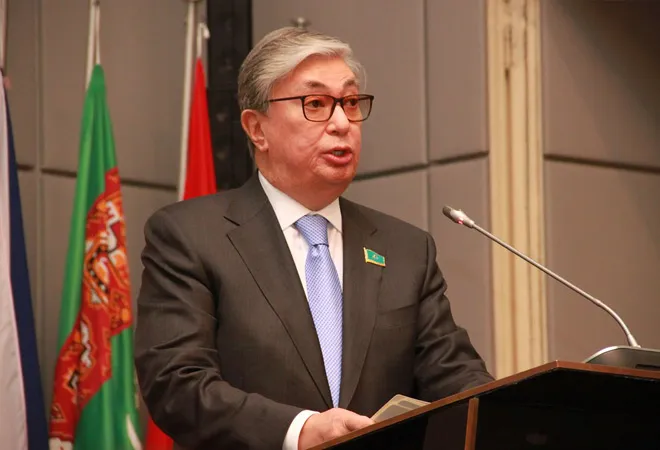
Weeks after President Kassym-Jomart Tokayev announced easing of the restrictive legislation on expression of dissent and public demonstrations in
his first state-of-the-nation speech, Kazakhstan–till recently an autocratic state – has seen a rise of sporadic protests against perceived Chinese economic invasion of the country. The wave of protests started from oil mining town of Zhanaozen in the first week of September and quickly spread in the cities of Aqtobe, Almaty, Shymkent and the capital city of Nur-Sultan. While the number of protesters was less initially, the numbers soared within days. According to
reports quoting interior ministry sources, 57 people were detained in Almaty and Nur-Sultan on 21 September 2019. The sudden uprising against Chinese investments and loans has created a dilemma for the new president, Kassym-Jomart Tokayev as Kazakhstan is slated to receive Chinese
assistance for the construction of 50 new industrial facilities in the near future.
Kazakh’s suspicion of China has a long history, dating back to hundreds of years. Buhar-Jiru, an advisor to 18
th century political leader Abulai Khan, had used the traditional nomadic metaphor of a rider and a horse to present his perception of China. He had said, “Russian yoke is made of leather that can gradually be worn out while Chinese yoke is made of iron and one can’t free oneself from it”.
However, the current wave of resentment towards Chinese influence has seen an upswing since
2016, when people protested in huge numbers against the country's Land Code that enabled government sales or leases of agricultural land to foreigners/Chinese for a period of 25 years. The protestors feared that Chinese investors will use their land ownership in Kazakhstan to gradually exercise their influence and dominance. This time around, however, the protestors are additionally motivated by China’s ethnocultural onslaught in Xinjiang. Today, more than
400,000 Uyghurs live in Kazakhstan as exiles following China’s ‘Great Leap Forward’ in 1957. Besides, 1,810,507 Kazakhs, 196,320 Kyrgyz and many Uzbeks are also living in
Xinjiang. Since ancient times, the people living in these Central Asian countries had strong socio-cultural, economic and political relationship with the indigenous people of Xinjiang, with Kashghar, Yarkand and Khotan being the key centers of commerce along the Silk Route trade.
Following the collapse of the Soviet Union, China has exploited Kazakhstan to pursue its goals of economic dominance and sinicisation of its restive province of Xinjiang. Chinese government is of the opinion that diplomacy in Central Asia corresponds to its “Five Principles of Peaceful Coexistence” that is respect for “sovereignty and territorial integrity of other countries, absence of aggression, noninterference in internal affairs, mutual equality and mutual benefits”. To achieve these goals, Beijing solved the long-standing border dispute with Kazakhs in 1994 and both became the founding members of Shanghai Cooperation Organisation (SCO). The importance of Kazakhstan increased for China in its pursuit of hegemonic and geostrategic ambitions in the region. President Xi Jinping, while unveiling the much-hyped Chinese concept of One Belt One Road (later rechristened as the Belt and Road Initiative) in Kazakhstan, said that all Central Asian countries “should take an innovative approach” and collaborate with China in setting up “an economic belt along the Silk Road”.
Trade ties between China and Kazakhstan have strengthened over the last 28 years. Horgos International Border Cooperation Centre, a free trade zone was opened on the border between China and Kazakhstan in 2012 to facilitate trade and tourism. Trade volume between the two countries reached $
19.88 billion in 2018. China heavily invested in Kazakhstan’s hydrocarbon sector, especially in oil and gas. In the first half of 2019, China-Central Asia gas pipeline–connecting Turkmenistan with China–delivered 23 billion cubic meters of natural gas to Beijing. China also received 5.9 million tonnes of crude oil during the same period from the China-Kazakhstan oil
pipeline.
The latest wave of protests started against the Government’s pronouncement to allow the Chinese to setup 55 factories that will deepen Kazakhstan’s economic dependence on China. However, the people fear that the deal that was signed two years ago will allow more Chinese settlements in Kazakhstan rather than create any fruitful job oppportunities for
natives.
Another important factor that creates anti-China perception among the Kazakhs is the rising detentions of Uyghur, Kazakh and other Muslims in Xinjiang. So far, more than one million Muslims – including Uyghurs and Kazakhs – have been sent to “
re-education camps” in Xinjiang. In these detention centers, people are forced to pledge loyalty to the Chinese Communist Party (CCP), learn Mandarin and denounce Islam and their
culture. These re-education camps have left the Kazakh government and officials in a tangle between Beijing and their own citizens. The government has to now ensure that it keeps China, its political, economic and strategic partner happy, while quelling an increasingly exasperated segment of the Kazakh population worried about the fate of their relatives and ethnic brethren in neighbouring
China, especially in the volatile Xinjiang province.
The pressure on the Kazakh government is mounting as many Kazakhs have returned to their homeland following the
repatriation programme of the government under which the scattered Kazakh ethnic groups across Central Asia and China were given citizenship in Kazakhstan. This repatriation programme left families divided between Xinjiang and Kazakhstan, separated by dual citizenship and residence status. Additionally, the CCP has threatened all those Kazakhs who live in Xinjiang who visit their families in their home country with imprisonment. As more and more Kazakhs are coming out of these re-education camps in Xinjiang through government lobbying with Beijing, more stories of torture and forced assimilation have come to the fore. Now with mega Chinese investments in the pipeline, the Kazakh government has started to face increasing pressure from its own people to denounce China’s plans as Beijing has not respected the ethnic and cultural identity of the Kazakhs and even Uyghurs living in Xinjiang.
Chinese principles in Central Asia are hegemonic. China has always interacted with Central Asian states without regarding their cultural identities, but according to its own vested interests. For example, the Chinese provided loans, concessions and chief commodities during the first 10 years to the Central Asian rulers to sustain their autocratic rule. In return for this gesture, the rulers of Centre Asia kept vigil on Uyghur organisations. They even banned these organisations after 1997. However, the ongoing anti-China sentiments may be coming to a tipping point. The Kazakh government has been forced to officially recognise the Xinjiang rights movement,
Ata-Jurt, which highlights the mass detention of ethnic Kazakhs in western China.
How President Tokayev walks the tightrope in the coming months will determine the fate of China’s ambitious Belt and Road Initiative, to which, Central Asia provides the backbone.
The views expressed above belong to the author(s). ORF research and analyses now available on Telegram! Click here to access our curated content — blogs, longforms and interviews.



 Weeks after President Kassym-Jomart Tokayev announced easing of the restrictive legislation on expression of dissent and public demonstrations in
Weeks after President Kassym-Jomart Tokayev announced easing of the restrictive legislation on expression of dissent and public demonstrations in  PREV
PREV


